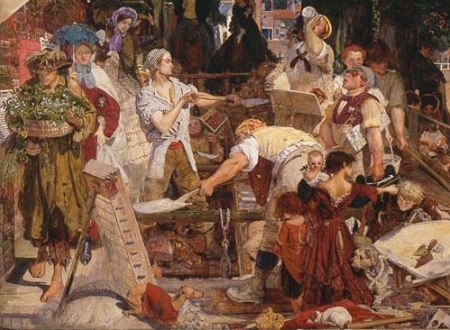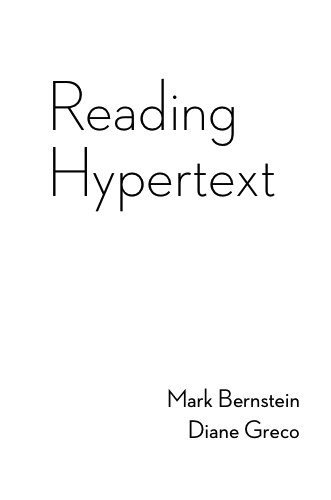Hypertext And Realism
Stacey Mason

Ford Maddox Brown, Work (detail), Manchester Art Gallery
Lorie Emerson tweets, “Hypertext is the new realism,” a reflection that deserves some thought. Hypertext has long been associated with postmodernism, and occasionally with modernism, but realism has never really crossed my mind. It’s an interesting claim, one that probably needs clarification in a field of mixed ontologies and contended vocabularies.
First, what do we mean by “hypertext?” HTLit (and our sponsor Eastgate Systems) takes a broad view of “hypertext,” encompassing any kind of linked structures or interactive work. Links don’t have to be underlined blue bits of text; they are evident through a reaction within the work that is triggered not just by clicking, but by any interaction that the author specifies should cause something to happen. However, the idea of “hypertext fiction” put forth by Kate Hayles in Electronic Literature is probably more widely used within the field. She breaks electronic literature into “genres,” distinguishing “hypertext fiction” for its lack of sound, image, and video as the “first generation” or “classical” works, (echoing Coover’s Golden Age) thereby limiting the scope of what “hypertext literature” actually includes.
By “realism” I assume we’re talking about the 19th century artistic movement that focused on capturing an objective truth. But how is hypertext (either as a subset of eLit or as an encompassing entity) realism or something like it?
If we limit the scope of hypertext to Hayles’ definition, many of these pieces were direct in their representation of the structure of the work. Readers could see the entirety of a work’s structure more clearly than is possible in interactive fiction, for example. However, this is not true for all of them, especially once we started viewing hypertext work on the Web. Likewise, if we’re interested in visual aesthetics of hypertext pages and their stripped-down appearance, surely IF is a closer fit, especially works like Dan Dan Shiovitz’s Bad Machine, though arguably their awareness of this fact puts them more in line with moderism or postmoderism.
In visual art, the practice of realism was influenced by the camera, a revolutionary technology affording new artistic possibilities and in turn influencing aesthetic sensibilities. Camera’s could produce images that seemed to captured the objective truth. Perhaps like the camera, hypertext has not only acted as a new technology that allows for innovative forms of electronic literature, but it has also changed our sense of what makes a work of eLit good. Surely, though, every artistic movement has faced similar changes in critical practice, and technology has always shaped art.
If we limit the scope of “realism” to literature, the search for the objective truth manifested a focus on gritty realistic depictions of life and hardship. Hypertext is perhaps analogous, as it reflects intricacies of connectivity that have become more and more foregrounded in 21st century life. If moderism’s stream of consciousness is a romantic impression of the mind at work, perhaps hypertext’s fragmented and sporadic paths and its dead ends are the reality of the contemporary experience, a gritty representation to overtake that romantic ideal.
We might have come to a new objective truth here, except that many of these works actually deemphasize the idea of an objective reality. Instead, they highlight the fact that truth, meaning, and interpretation of experience are created by context; the reader imposes them onto the artistic vessel. Although hypertext may seek to capture a “realistic” view of connectivity and intertwingledness, its heart still lies with postmodernist relativism.
